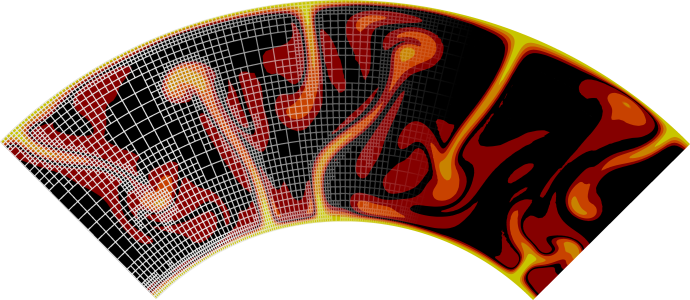Stokes solver#
Problems in ASPECT require solving the Stokes problem below for velocity \(u\) and pressure \(p\)
equipped with boundary conditions. We only discuss the incompressible Stokes equations in this page, but ASPECT does indeed feature compressible solvers.
Here, \(x\) lies in our domain \(\Omega\) and \(\eta(x)\) is our viscosity. \(\varepsilon(u)=\frac{1}{2}(\nabla u+ \nabla u^T)\) is known as the strain rate tensor.
In this document, we discuss the case of Dirichlet boundary conditions \(u=g_D\) on \(\Gamma_D\) and Neumann \(n \cdot (pI-2\varepsilon(u))=g_N\) on \(\Gamma_N\).
To enable the computation of a numerical solution, and to loosen the regularity restrictions imposed on the velocity space by the strong formulation, we must first derive the weak form of the Stokes equations. This derivation can be found in step-22 of deal.II.
To derive the weak form, let \(u \in V_g:=\{\phi \in H^1(\Omega)^d: \phi_{\Gamma_D}=g_d\}\), \(v \in V_0=\{\phi \in H^1(\Omega)^d: \phi_{\Gamma_D}=0\}\). We call \(V_g\) the solution space and \(V_0\) the test space.
Multiplying the first equation in the strong form by \(v \in V_0\) and integrating by parts:
where we use that \((n \otimes v,2\eta(x)\varepsilon(u))_{\Gamma_D}+(n\cdot v,p)_{\Gamma_D}=0\) due to the definition of \(V_0\), and the observation that \((2\eta(x)\varepsilon(u),\nabla v)=(2\eta(x)\varepsilon(u),\varepsilon(v))\).
Of course, the \(\nabla \cdot u =0\) must also be incorporated into the weak formulation. Multiplying by \(q \in Q=L^2\), we get \((q,\nabla \cdot u)=0\).
Combining these two results, we have the weak form
where we apply the Neumann boundary condition to get the \((v,g_N)_{\Gamma_N}\) term from \((v,n \cdot(pI-2\varepsilon(u)_{\Gamma_N}))\).
We proceed now to the discrete weak form. In order to guarantee existence and uniqueness of the discrete velocity and pressure solution, we search for \(u_h \in Q_{k+1}^d\) and \(p_h \in Q_k\), with \(k \geq 1\). The use of \(Q_{k+1}\) for velocity and \(Q_k\) for pressure for \(k \geq 1\) satisfies the inf-sup condition and is typically known as the Taylor-Hood pair. Other options are available in ASPECT, including discontinuous pressure and Q1-Q1 stabilized.
This yields the linear system
Here, \(A\) is the viscous stress matrix, \(B^T\) is the discrete gradient operator on the pressure space, and \(B\) is the divergence operator on the velocity space.
We solve this linear system iteratively with preconditioner of the form
applied from the right.
The motivation for this is that
Notice that \(A\widetilde{A}^{-1}\) in the top left block and \(BA^{-1}B^TS^{-1}\) in the bottom right block. This \(BA^{-1}B^T\) is often referred to as the negative Schur Complement. The effectiveness of the preconditioner depends significantly on how well \(S^{-1}\) approximates the inverse of the negative Schur complement.
Pressure Scaling#
ASPECT uses dimensional units, and consequently a pressure scaling factor based on reference viscosity and length scale is required in order to ensure the iterative solver enforces both equations in the Stokes system. To understand why, we need to examine the iterative linear solver [Kronbichler et al., 2012].
An iterative method such as GMRES will continue iteration until
We must be aware that the \(U\) block corresponding to velocity and \(P\) block corresponding to pressure will have different units, and this generally leads to one of the equations, likely \(\nabla \cdot u=0\), not being enforced. This is because the two equations have vastly different numerical values, meaning one will contribute to the residual significantly more than the other.
For instance, assume the residual of the first block has associated units \(\frac{Pa}{m} m^{\text{dim}}\) where \(Pa=\frac{kg}{ms^2}\) and the residual of the second block has units \(\frac{m^{\text{dim}}}{s}\). Then the norm of the residual vector has units \(m^{\text{dim}-1}\sqrt{(Pa)^2+(\frac{m}{s})^2}\).
To remedy this, we recall our Stokes system of the form
We introduce the pressure scaling \(\lambda:=\frac{\eta}{L}\) and scale \(\nabla \cdot u\) as follows:
where \(L\) is determined by length scale and computed reference viscosity.
However, notice that this destroys the symmetry we have between the \(B\) and \(B^T\) blocks of our Stokes system. To remedy this, let \(\widehat{p}=\lambda^{-1}p\). Then we can rewrite our system as
We immediately recover \(p\) from \(\widehat{p}\) after solving.

